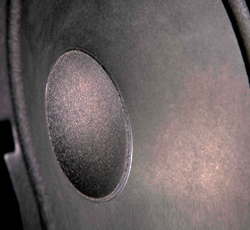
The Bass Challenge
In big sound systems, it’s not easy to get good bass. Lowering woofer distortion to an acceptable level is really difficult.
There are two main reasons for this:
1. Air is very thin stuff, and bass vibrations are relatively slow. For a slow-moving bass loudspeaker cone to have much effect on the air, it has to be large and it has to travel back and forth a long way. It may seem as though a high-power woofer is a powerful, rugged, macho device, but in reality it’s a piece of paper frantically flapping in the breeze, trying to make a difference. It’s not easy to make that kind of thing linear.By way of comparison, under water you can get loud bass down to 20 Hz from a 2-inch diameter woofer.
2. It’s surprising how low a level of distortion is actually required. There are two reasons for this: (a) the ear is 10-20 dB more sensitive to bass distortion harmonics than to the actual fundamental frequency, and (b) many people seem to like a lot of bass boost in PA systems.
My general rule of thumb is that 1 percent distortion in the subbass is equivalent to 7-10 percent distortion in most other parts of the frequency range.
You’ll remember from my old Jason Sound story above that when our woofers changed from 4 percent to 1 percent distortion, the effect was very obvious.Most modern woofers are rated for maximum output at 5-10 percent distortion. That’s a big part of the problem.
There’s another kind of challenge facing good concert bass: Because many, if not most, touring sound professionals haven’t heard good bass, they aren’t asking manufacturers for it. As a result, there are very few low-distortion concert woofer products available.
In studio monitoring and serious home stereo, the situation is somewhat different—many people know what good bass sounds like. In those markets, many manufacturers are serious about low bass distortion, and there are a number of successful products.
Getting It Where You Want It
If you do have a system capable of producing good bass, you’re still faced with the task of designing the woofer arrays for best coverage.
Bass coverage is very predictable, although sometimes the predictions dictate difficult loudspeaker arrangements for production. This has lead to a lot of denial in the business, in which sound people pretend to have good bass coverage in order to avoid conflicts with lighting, video, and staging colleagues.
Jeff Berryman served as the director of Jasonaudio, a touring sound company based in Canada, and is a senior scientist with Electro-Voice.
